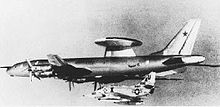Tupolev Tu-126 Video - Overview
|
|
Tupolev Tu-126
Tu-126

Picture - Tu-126
Role: Airborne Early Warning and Control
Manufacturer: Tupolev OKB
First flight: 23 January 1962
Introduced: 1965
Retired: 1984 (USSR)
Status: Retired
Primary user: Soviet Air Force
Number built: about 12
Developed from: Tupolev Tu-114
The Tupolev Tu-126 (NATO reporting name: Moss) was an Airborne Early Warning and Control aircraft developed from the Tupolev Tu-114 airliner by the Tupolev design bureau. It was in service with the armed forces of the Soviet Union from 1965 to 1984.
Design and development
In 1958 the Tupolev Design Bureau was ordered to design an AEW&C aircraft. After trying to fit the projected radar instrumentation in a Tu-95 and a Tu-116, the decision was made to use the Tupolev Tu-114 with its wider fuselage instead. This solved all the problems with cooling and operator space that existed with the narrower Tu-95 and Tu-116 fuselage. To adhere to the flight range requirements, the plane was fitted with an air-to-air refuelling probe. The Tu-126 had a crew of twelve and carried the Liana radar (NATO reporting name Flat Jack) in a rotordome mounted above the fuselage.
The first prototype Tu-126 flew on 23 January 1962. Testing showed that while the radar was effective over water, performance was poorer over land. It was found that the large counter-rotating metal propellers of the four engines seriously compromised the performance of the radar. This problem was only marginally countered by the installation of a new radar called Shmel.
Operational history

Picture - An A-4E from the USS Intrepid intercepting a Tu-126 over the Mediterranean Sea in 1973
The Tu-126 entered service in 1965, although it was only identified by Western intelligence in 1968 after appearing in a Soviet documentary film. Eight production aircraft were built in addition to the prototype from between 1965 and 1968. Western intelligence estimated that its radar performance was inferior to Western equivalents, that it was unable to detect cruise missiles or small aircraft at low level. However, it was assessed that the Tu-126 had powerful jamming equipment. The Tu-126 was used by the Soviet Air Force, until being replaced by the Beriev A-50. A single Tu-126 was also leased by India during the Indo-Pakistani War of 1971. The last Tu-126 was retired in 1984.
Operators
Soviet Union
Soviet Air Force
Soviet Anti-Air Defence
Specifications (Tu-126)
Data from The Osprey Encyclopedia of Russian Aircraft 1875-1995
General characteristics
Crew: 12 (plus full spare crew)
Length: 56.5 m (with re-fuelling probe) (185 ft 4â
in)
Wingspan: 51.4 m (168 ft 7â
in)
Height: 16.05 m (52 ft 8 in)
Wing area: 311.1 m² (3,348 ft²)
Empty weight: 103,000 kg (227,000 lb)
Loaded weight: 171,000 kg (377,000 lb)
Powerplant: 4x Kuznetsov NK-12MV turboprops driving contra-rotating propellors, 11,033 kW (14,795 hp) each
Performance
Maximum speed: 790 km/h (426 kt, 491 mph)
Cruise speed: 520 km/h (281 kt, 323 mph)
Range: 7,000 km (3,780 NM, 4,350 mi)
Service ceiling: 10,700 m (35,100 ft)
Rate of climb: m/s (ft/min)
Wing loading: 550 kg/m² (113 lb/ft²)
Power/mass: 0.26 kW/kg (0.16 hp/lb)
Related development
Tupolev Tu-95
Tupolev Tu-114
Tupolev Tu-142
Comparable aircraft
EC-121 Warning Star
Bibliography
Duffy, Paul and Kandalov, Andrei. Tupolev: The Man and His Aircraft. Shrewsbury, UK:Airlife, 1996. ISBN 1 85310 728 X.
Gunston, Bill. The Osprey Encyclopedia of Russian Aircraft 1875 - 1995. London: Osprey, 1995. ISBN 1-85532-405-9.
Taylor, John W.R., ed. Jane's All The World's Aircraft 1988-89. Coulsden, Surrey, UK: Jane's Information Group, 1988. ISBN 0 7106-0867-5.
Living Warbirds: The best warbirds DVD series.
Source: WikiPedia